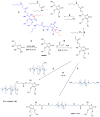Ascorbic Acid-Modified Silicones: Crosslinking and Antioxidant Delivery
- PMID: 36433164
- PMCID: PMC9693009
- DOI: 10.3390/polym14225040
Ascorbic Acid-Modified Silicones: Crosslinking and Antioxidant Delivery
Abstract
Vitamin C is widely used as an antioxidant in biological systems. The very high density of functional groups makes it challenging to selectively tether this molecule to other moieties. We report that, following protection of the enediol as benzyl ethers, the introduction of an acrylate ester at C1 is straightforward. Ascorbic acid-modified silicones were synthesized via aza-Michael reactions of aminoalkylsilicones with ascorbic acrylate. Viscous oils formed when the amine/acrylate ratios were <1. However, at higher amine/acrylate ratios with pendent silicones, a double reaction occurred to give robust elastomers whose modulus is readily tuned simply by controlling the ascorbic acid amine ratio that leads to crosslinks. Reduction with H2/Pd removed the benzyl ethers and led to increased crosslinking, and either liberated the antioxidant small molecule or produced antioxidant elastomers. These pro-antioxidant elastomers show the power of exploiting natural materials as co-constituents of silicone polymers.
Keywords: antioxidant activity; ascorbic acid; aza-Michael addition; reductive cleavage; silicone elastomer.
Conflict of interest statement
The authors declare no conflict of interest.
Figures




References
-
- Rasheed A., Azeez R.F.A., Rasheed A., Azeez R.F.A. A Review on Natural Antioxidants. IntechOpen; London, UK: 2019.
-
- Pospíšil J. Mechanistic Action of Phenolic Antioxidants in Polymers-A Review. Polym. Degrad. Stab. 1988;20:181–202. doi: 10.1016/0141-3910(88)90069-9. - DOI
-
- Estevinho B.N., Carlan I., Blaga A., Rocha F. Soluble Vitamins (Vitamin B12 and Vitamin C) Microencapsulated with Different Biopolymers by a Spray Drying Process. Powder Technol. 2016;289:71–78. doi: 10.1016/j.powtec.2015.11.019. - DOI
Grants and funding
LinkOut - more resources
Full Text Sources

